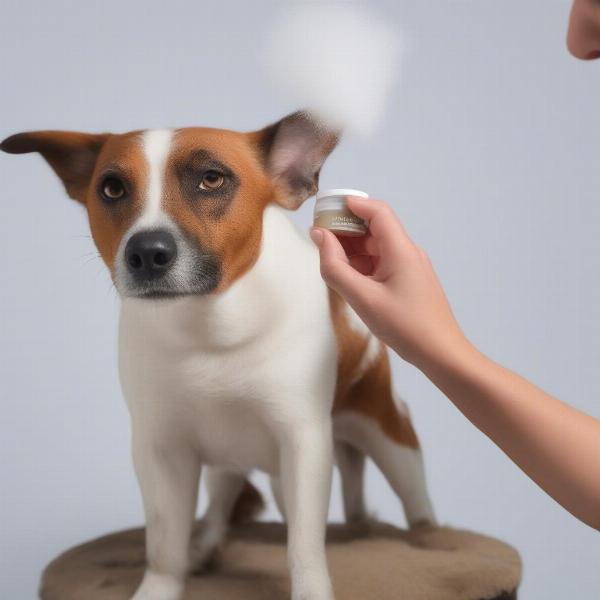Hotspot powder for dogs is a topical treatment option for acute moist dermatitis, commonly known as hot spots. These itchy, painful sores can develop quickly and cause significant discomfort for your canine companion. Understanding how to use hotspot powder effectively, along with preventative measures and alternative treatments, is crucial for managing this common skin condition.
Understanding Hot Spots in Dogs
Hot spots are inflamed, infected patches of skin that appear suddenly, often seeming to erupt overnight. They are typically round or oval and can be moist, oozing, and incredibly itchy. Dogs will often lick, chew, and scratch the affected area, which unfortunately exacerbates the problem and spreads the infection. Several factors can contribute to the development of hot spots, including allergies, flea and tick bites, skin infections, and even boredom or stress. Recognizing the signs of a hot spot is the first step in providing effective treatment.
How Hotspot Powder Works
Hotspot powder for dogs typically contains active ingredients with antiseptic, astringent, and drying properties. These ingredients work together to soothe the irritated skin, reduce inflammation, and dry out the moist, oozing lesion. Some common ingredients found in hotspot powder include chlorhexidine, ketoconazole, and zinc oxide. These ingredients help to control bacterial and fungal growth, which are common secondary infections associated with hot spots.  Applying hotspot powder to a dog
Applying hotspot powder to a dog
Using Hotspot Powder Effectively
Before applying hotspot powder, it’s crucial to clean the affected area gently with a mild antiseptic solution and clip away the surrounding fur. This allows the powder to come into direct contact with the lesion and promotes healing. Apply a thin layer of powder directly onto the hot spot, ensuring not to rub it in vigorously. It’s generally recommended to apply the powder two to three times daily, or as directed by your veterinarian.
When to Seek Veterinary Care
While hotspot powder can be effective for mild cases, it’s important to consult with a veterinarian if the hot spot is severe, spreads rapidly, or doesn’t show improvement within a few days. Your vet can determine the underlying cause of the hot spot and recommend the most appropriate treatment plan. They may prescribe antibiotics, antifungal medications, or anti-inflammatory drugs to address the infection and discomfort.
Preventing Hot Spots
Preventing hot spots is often easier than treating them. Regular grooming, flea and tick prevention, and managing underlying allergies can significantly reduce the risk. Keeping your dog’s coat clean and dry, especially during warm and humid weather, can also help prevent hot spots from developing. Providing a stimulating and enriching environment can also help reduce stress and boredom, which can sometimes contribute to excessive licking and chewing.
Alternative Treatments for Hot Spots
Several alternative treatments for hot spots exist, including medicated shampoos, sprays, and wipes. Some pet owners also find success with natural remedies like aloe vera or chamomile compresses. However, it’s always best to consult your vet before using any alternative treatment, to ensure it’s safe and appropriate for your dog. You can learn more about managing fungal infections with our article on fungal shampoo dogs.
Conclusion
Hotspot powder can be a useful tool in managing hot spots in dogs, providing relief from itching and promoting healing. However, it’s essential to use it correctly and in conjunction with veterinary guidance, especially for severe or persistent cases. By understanding the causes of hot spots and implementing preventative measures, you can help keep your canine companion comfortable and free from this frustrating skin condition.
FAQ
- How often should I apply hotspot powder to my dog? Apply the powder two to three times daily, or as directed by your veterinarian.
- Can I use human hotspot powder on my dog? No, always use products specifically formulated for dogs.
- What should I do if my dog keeps licking the hot spot? Consider using an Elizabethan collar to prevent further irritation.
- Are hot spots contagious to other dogs? While the infection itself isn’t directly contagious, the underlying causes (like allergies or parasites) can be.
- How can I prevent hot spots in my dog? Regular grooming, flea and tick prevention, and allergy management are key preventative measures.
- Can stress cause hot spots in dogs? Yes, stress and boredom can contribute to excessive licking and chewing, which can lead to hot spots.
- What are the signs of a serious hot spot? Rapid spreading, excessive swelling, discharge, and lethargy are signs you should seek veterinary care immediately.
ILM Dog is your trusted resource for expert advice on dog breeds, health, training, nutrition, grooming, and more. We provide reliable, practical information for dog owners of all experience levels, helping you navigate every aspect of dog care. Our expertise covers a wide range of topics from choosing the right breed to understanding complex health issues. For professional advice tailored to your dog’s specific needs, reach out to us at [email protected] or call +44 20-3965-8624. ILM Dog is dedicated to helping you give your furry friend the best possible care.